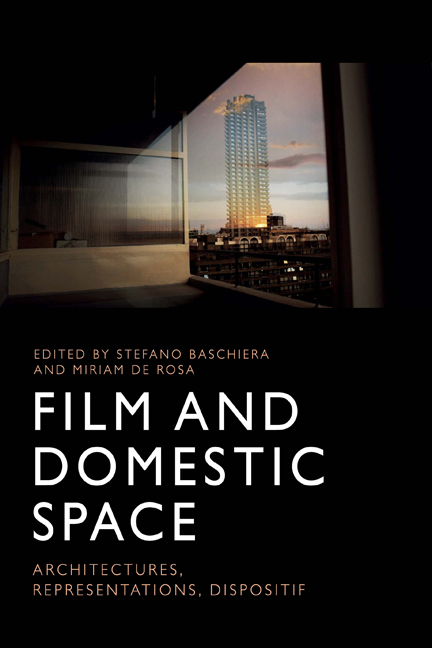Book contents
- Frontmatter
- Contents
- List of Figures
- Notes on the Contributors
- Acknowledgements
- Introduction
- 1 Architectures of Ubiquity: The Colonial Revival in Film and Television
- 2 No Down Payment: Whiteness, Japanese American Masculinity and Architectural Space in the Cinematic Suburbs
- 3 Resist, Redefine, Appropriate: Negotiating the Domestic Space in Contemporary Female Biopics
- 4 Liminal Spaces, Lesbian Desire and Veering off Course in Todd Haynes’s Carol
- 5 A Home on the Road in Claire Denis’s Vendredi soir
- 6 Acoustic Ectoplasm and the Loss of Home
- 7 Our House Now: Flat and Reversible Home Spaces in Post-war Film and Television
- 8 From Myth to Reality: Images of Domestic Space in Post-Soviet Baltic Films
- 9 No | Home | Movie: Essay Film, Architecture as Framing and the Non-house
- 10 At Home with the Nouvelle Vague: Apartment Plots and Domestic Urbanism in Godard’s Une femme est une femme and Varda’s Cléo de 5 à 7
- 11 Dwelling the Open: Amos Gitai and the Home of Cinema
- 12 What Is Cult When It’s At Home? Reframing Cult Cinema in Relation to Domestic Space
- 13 High-fructose Cinema and the Movie Industrial Complex: Radicalising the Technology of Representation in a Domestic Kind of Way
- Index
7 - Our House Now: Flat and Reversible Home Spaces in Post-war Film and Television
Published online by Cambridge University Press: 22 September 2020
- Frontmatter
- Contents
- List of Figures
- Notes on the Contributors
- Acknowledgements
- Introduction
- 1 Architectures of Ubiquity: The Colonial Revival in Film and Television
- 2 No Down Payment: Whiteness, Japanese American Masculinity and Architectural Space in the Cinematic Suburbs
- 3 Resist, Redefine, Appropriate: Negotiating the Domestic Space in Contemporary Female Biopics
- 4 Liminal Spaces, Lesbian Desire and Veering off Course in Todd Haynes’s Carol
- 5 A Home on the Road in Claire Denis’s Vendredi soir
- 6 Acoustic Ectoplasm and the Loss of Home
- 7 Our House Now: Flat and Reversible Home Spaces in Post-war Film and Television
- 8 From Myth to Reality: Images of Domestic Space in Post-Soviet Baltic Films
- 9 No | Home | Movie: Essay Film, Architecture as Framing and the Non-house
- 10 At Home with the Nouvelle Vague: Apartment Plots and Domestic Urbanism in Godard’s Une femme est une femme and Varda’s Cléo de 5 à 7
- 11 Dwelling the Open: Amos Gitai and the Home of Cinema
- 12 What Is Cult When It’s At Home? Reframing Cult Cinema in Relation to Domestic Space
- 13 High-fructose Cinema and the Movie Industrial Complex: Radicalising the Technology of Representation in a Domestic Kind of Way
- Index
Summary
‘A home – isn't that an optical thing?’ (Émile Rousseau [Jean-Pierre Léaud] in Le gai savoir, Jean-Luc Godard, 1969)
Preamble
The essay that follows is a hybrid of academic research and poetic or creative research. In fact, it is less a bounded essay than a fragment of a thread of work that I have been tracing for over thirty years. Poetic research begins not from a thesis or intuition to be argued and proven, but from a figure or trope – necessarily shadowy, multiple in its social meanings and uses, perhaps somewhat ‘mythic’ (see Schwartz 2014 for one model of this type of research and writing). This figure is then (as it were) placed at the centre of an empty field, a mental screen. Gradually, over time, examples arrive to associate or constellate themselves around the central figure; it is a work of accumulation, and also serendipity. Different ‘families’, subgroups, variations and metamorphoses of the figure form across the board. A rhizomatic logic may appear, connecting some of the zones or layers bunched on the field/screen. One discovers what the diagram is about by following its paths, meditating upon it. In a very real sense, the subsequent narration of these research endings can begin or end anywhere, since the entire process is in media res, always happening in the midst of things; no linear chronology, no rhetoric of ‘overview’ is possible.
Nonetheless, for the sake of an initial orientation to this sliced fragment, I shall point to the schema that formed here around the initially chosen figure of ‘home’ and its spaces. A history of sorts is inaugurated in the post-Second World War period with John Ford's iconic images of a home in his classic Western The Searchers (1956). It is here, I have come to believe, that a first true ‘haunting’ or evacuation of home space – outside of the generic confines of horror and fantasy cinema – begins. But a slightly earlier work little seen in its time, Josef von Sternberg's The Saga of Anatahan (1953), has revealed itself, across a cultural ‘delay’, as an even more radical instigation of what I call the boomerang effect of reversible space: once domestic space is flattened and emptied out so thoroughly, it sends us, the spectators, back to our own resources and origins.
- Type
- Chapter
- Information
- Film and Domestic SpaceArchitectures, Representations, Dispositif, pp. 118 - 133Publisher: Edinburgh University PressPrint publication year: 2020



